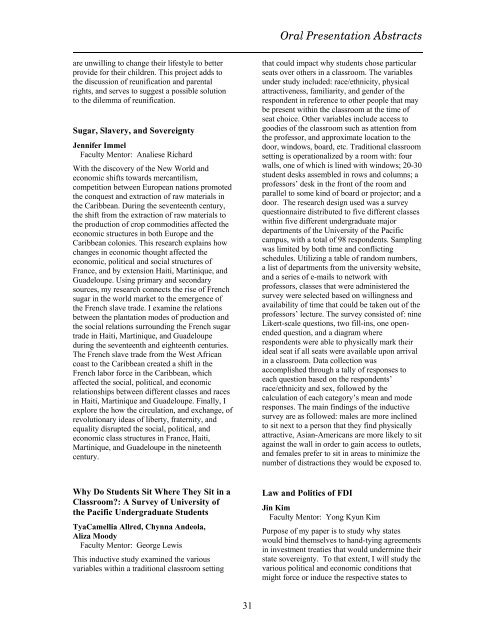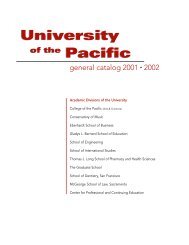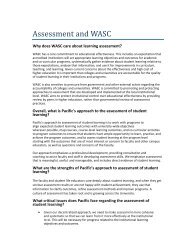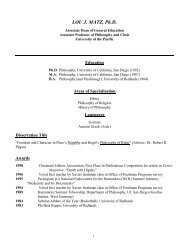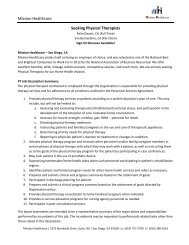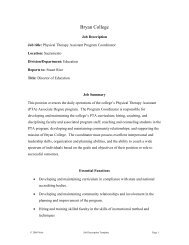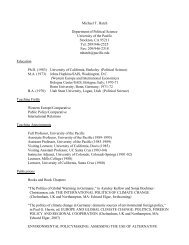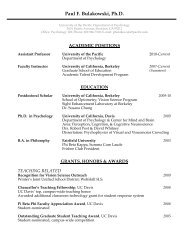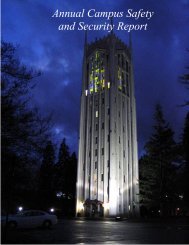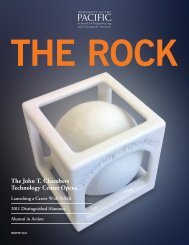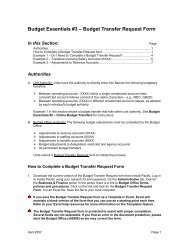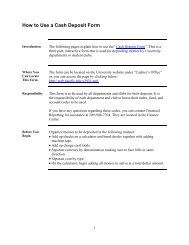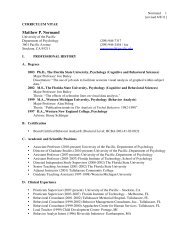purcc 2012 - University of the Pacific
purcc 2012 - University of the Pacific
purcc 2012 - University of the Pacific
You also want an ePaper? Increase the reach of your titles
YUMPU automatically turns print PDFs into web optimized ePapers that Google loves.
Oral Presentation Abstracts<br />
are unwilling to change <strong>the</strong>ir lifestyle to better<br />
provide for <strong>the</strong>ir children. This project adds to<br />
<strong>the</strong> discussion <strong>of</strong> reunification and parental<br />
rights, and serves to suggest a possible solution<br />
to <strong>the</strong> dilemma <strong>of</strong> reunification.<br />
Sugar, Slavery, and Sovereignty<br />
Jennifer Immel<br />
Faculty Mentor: Analiese Richard<br />
With <strong>the</strong> discovery <strong>of</strong> <strong>the</strong> New World and<br />
economic shifts towards mercantilism,<br />
competition between European nations promoted<br />
<strong>the</strong> conquest and extraction <strong>of</strong> raw materials in<br />
<strong>the</strong> Caribbean. During <strong>the</strong> seventeenth century,<br />
<strong>the</strong> shift from <strong>the</strong> extraction <strong>of</strong> raw materials to<br />
<strong>the</strong> production <strong>of</strong> crop commodities affected <strong>the</strong><br />
economic structures in both Europe and <strong>the</strong><br />
Caribbean colonies. This research explains how<br />
changes in economic thought affected <strong>the</strong><br />
economic, political and social structures <strong>of</strong><br />
France, and by extension Haiti, Martinique, and<br />
Guadeloupe. Using primary and secondary<br />
sources, my research connects <strong>the</strong> rise <strong>of</strong> French<br />
sugar in <strong>the</strong> world market to <strong>the</strong> emergence <strong>of</strong><br />
<strong>the</strong> French slave trade. I examine <strong>the</strong> relations<br />
between <strong>the</strong> plantation modes <strong>of</strong> production and<br />
<strong>the</strong> social relations surrounding <strong>the</strong> French sugar<br />
trade in Haiti, Martinique, and Guadeloupe<br />
during <strong>the</strong> seventeenth and eighteenth centuries.<br />
The French slave trade from <strong>the</strong> West African<br />
coast to <strong>the</strong> Caribbean created a shift in <strong>the</strong><br />
French labor force in <strong>the</strong> Caribbean, which<br />
affected <strong>the</strong> social, political, and economic<br />
relationships between different classes and races<br />
in Haiti, Martinique and Guadeloupe. Finally, I<br />
explore <strong>the</strong> how <strong>the</strong> circulation, and exchange, <strong>of</strong><br />
revolutionary ideas <strong>of</strong> liberty, fraternity, and<br />
equality disrupted <strong>the</strong> social, political, and<br />
economic class structures in France, Haiti,<br />
Martinique, and Guadeloupe in <strong>the</strong> nineteenth<br />
century.<br />
that could impact why students chose particular<br />
seats over o<strong>the</strong>rs in a classroom. The variables<br />
under study included: race/ethnicity, physical<br />
attractiveness, familiarity, and gender <strong>of</strong> <strong>the</strong><br />
respondent in reference to o<strong>the</strong>r people that may<br />
be present within <strong>the</strong> classroom at <strong>the</strong> time <strong>of</strong><br />
seat choice. O<strong>the</strong>r variables include access to<br />
goodies <strong>of</strong> <strong>the</strong> classroom such as attention from<br />
<strong>the</strong> pr<strong>of</strong>essor, and approximate location to <strong>the</strong><br />
door, windows, board, etc. Traditional classroom<br />
setting is operationalized by a room with: four<br />
walls, one <strong>of</strong> which is lined with windows; 20-30<br />
student desks assembled in rows and columns; a<br />
pr<strong>of</strong>essors’ desk in <strong>the</strong> front <strong>of</strong> <strong>the</strong> room and<br />
parallel to some kind <strong>of</strong> board or projector; and a<br />
door. The research design used was a survey<br />
questionnaire distributed to five different classes<br />
within five different undergraduate major<br />
departments <strong>of</strong> <strong>the</strong> <strong>University</strong> <strong>of</strong> <strong>the</strong> <strong>Pacific</strong><br />
campus, with a total <strong>of</strong> 98 respondents. Sampling<br />
was limited by both time and conflicting<br />
schedules. Utilizing a table <strong>of</strong> random numbers,<br />
a list <strong>of</strong> departments from <strong>the</strong> university website,<br />
and a series <strong>of</strong> e-mails to network with<br />
pr<strong>of</strong>essors, classes that were administered <strong>the</strong><br />
survey were selected based on willingness and<br />
availability <strong>of</strong> time that could be taken out <strong>of</strong> <strong>the</strong><br />
pr<strong>of</strong>essors’ lecture. The survey consisted <strong>of</strong>: nine<br />
Likert-scale questions, two fill-ins, one openended<br />
question, and a diagram where<br />
respondents were able to physically mark <strong>the</strong>ir<br />
ideal seat if all seats were available upon arrival<br />
in a classroom. Data collection was<br />
accomplished through a tally <strong>of</strong> responses to<br />
each question based on <strong>the</strong> respondents’<br />
race/ethnicity and sex, followed by <strong>the</strong><br />
calculation <strong>of</strong> each category’s mean and mode<br />
responses. The main findings <strong>of</strong> <strong>the</strong> inductive<br />
survey are as followed: males are more inclined<br />
to sit next to a person that <strong>the</strong>y find physically<br />
attractive, Asian-Americans are more likely to sit<br />
against <strong>the</strong> wall in order to gain access to outlets,<br />
and females prefer to sit in areas to minimize <strong>the</strong><br />
number <strong>of</strong> distractions <strong>the</strong>y would be exposed to.<br />
Why Do Students Sit Where They Sit in a<br />
Classroom?: A Survey <strong>of</strong> <strong>University</strong> <strong>of</strong><br />
<strong>the</strong> <strong>Pacific</strong> Undergraduate Students<br />
TyaCamellia Allred, Chynna Andeola,<br />
Aliza Moody<br />
Faculty Mentor: George Lewis<br />
This inductive study examined <strong>the</strong> various<br />
variables within a traditional classroom setting<br />
Law and Politics <strong>of</strong> FDI<br />
Jin Kim<br />
Faculty Mentor: Yong Kyun Kim<br />
Purpose <strong>of</strong> my paper is to study why states<br />
would bind <strong>the</strong>mselves to hand-tying agreements<br />
in investment treaties that would undermine <strong>the</strong>ir<br />
state sovereignty. To that extent, I will study <strong>the</strong><br />
various political and economic conditions that<br />
might force or induce <strong>the</strong> respective states to<br />
31


